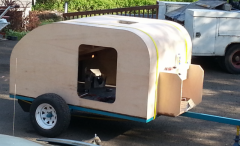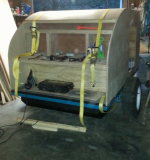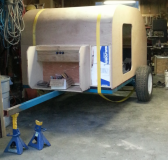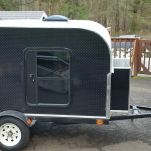
5X8 Modified Benroy Build (Flat Back)
61 posts
• Page 3 of 5 • 1, 2, 3, 4, 5
Re: First Build - 2014
Nice work. The pillow light/shelf bracket turned out nicely. 

KC
My Build: The Poet Creek Express Hybrid Foamie
Poet Creek Or Bust
Engineering the TLAR way - "That Looks About Right"
TnTTT ORIGINAL 200A LANTERN CLUB = "The 200A Gang"
Green Lantern Corpsmen
My Build: The Poet Creek Express Hybrid Foamie
Poet Creek Or Bust
Engineering the TLAR way - "That Looks About Right"
TnTTT ORIGINAL 200A LANTERN CLUB = "The 200A Gang"
Green Lantern Corpsmen
-

KCStudly - Donating Member
- Posts: 9640
- Images: 8169
- Joined: Mon Feb 06, 2012 10:18 pm
- Location: Southeastern CT, USA
Flexing (plywood)
Saturday I got the outer plywood on my trailer. It went surprisingly well. The 2.7mm meranti plywood bent my 19" radius in front with a little help from some large ratchet straps and some boards laid lengthwise in the tightest part of the curve. It really looks like a teardrop trailer now!

Next up, building and skinning the hatch. I may be doing fiberglass this weekend, so things could move along rapidly.

I made a little stereo enclosure to stick on the front shelf.

Out of the shop for the first time in weeks. Turned it around and wheeled it back in again all my myself, so I suppose that means it's still quite lightweight. (I'd guess tongue weight around 60-80 right now. That will go up with a battery in the tongue box.)



Next up, building and skinning the hatch. I may be doing fiberglass this weekend, so things could move along rapidly.
I made a little stereo enclosure to stick on the front shelf.
Out of the shop for the first time in weeks. Turned it around and wheeled it back in again all my myself, so I suppose that means it's still quite lightweight. (I'd guess tongue weight around 60-80 right now. That will go up with a battery in the tongue box.)
Never mind the maneuvers, always go straight at 'em. - Horatio Nelson
-

Eulalia - Donating Member
- Posts: 46
- Images: 90
- Joined: Thu Jun 12, 2014 4:00 pm
- Location: Southwest Washington State


 After doing some research, I decided to remove my home-built frame and purchase a 5x8 frame from Northern Tool. Here in Washington, licensing the manufactured frame will be much easier. This is now to become a clearly removable teardrop pod mounted on a utility trailer, especially since a trailer of this size does not need to be licensed at all in Oregon, where I will be camping, so I'll take my chances with the risk of an overly particular traffic stop on the Washington side.
After doing some research, I decided to remove my home-built frame and purchase a 5x8 frame from Northern Tool. Here in Washington, licensing the manufactured frame will be much easier. This is now to become a clearly removable teardrop pod mounted on a utility trailer, especially since a trailer of this size does not need to be licensed at all in Oregon, where I will be camping, so I'll take my chances with the risk of an overly particular traffic stop on the Washington side. (well, apart from work, but I get paid for that, and don't have to take it home in the evenings) I should add: Another reason to do the canvas covering is I can still apply panels and trim (filon, FRP, aluminum, etc) at a later date if I really got the urge to do so.
(well, apart from work, but I get paid for that, and don't have to take it home in the evenings) I should add: Another reason to do the canvas covering is I can still apply panels and trim (filon, FRP, aluminum, etc) at a later date if I really got the urge to do so.
 . You could get some practice in by covering a plywood cargo box or something of the sort.
. You could get some practice in by covering a plywood cargo box or something of the sort.